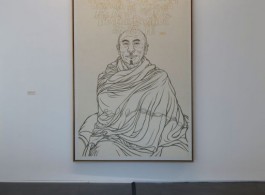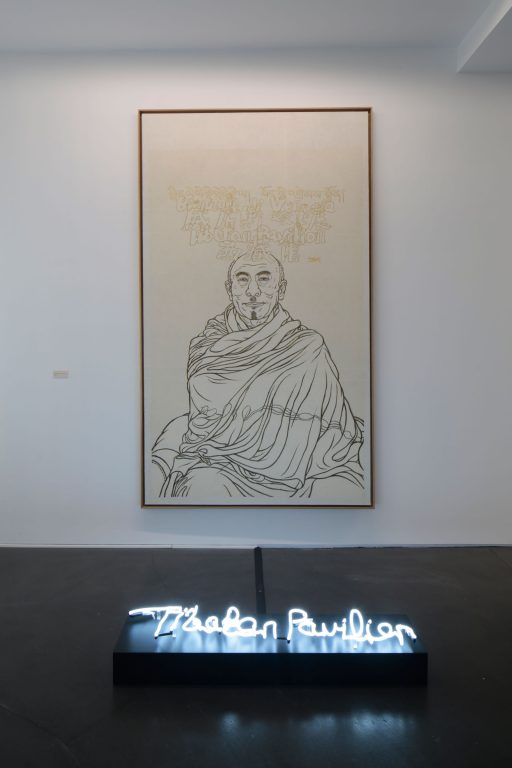“On Earth as in Heaven”
Galerie Jeanne Bucher Jaeger
Paris
On the occasion of YANG Jiechang’s 60th birthday, a solo exhibition entitled On Earth as in Heaven takes place at Galerie Jeanne Bucher Jaeger (Paris) presenting around 20 works by the artist, from different creative periods, as dense in content as they are in expression.
Yang Jiechang was born in 1956 in Foshan in southern China where he lived until 1978. He was deeply affected by the Cultural Revolution proclaimed by Mao Zedong in 1966. After briefly joining the red guards in the 1970s, he quickly distanced himself
studying calligraphy and deciding to study Chinese art history theory at the Canton Fine Arts Academy where he was also trained in the traditional art of ink painting. Gaining a considerable mastery of calligraphy and acute knowledge of traditional Chinese thinking, Yang Jiechang decided to be initiated over a period of several years into Taoism and Zen Buddhism which proved vital for the development of his formal language reduced to the essential.
The interest in history, in suffering and failure, and, on the aesthetic level, in a raw and immediate appearance is already evident in this and other early paintings. As the title suggests, Massacre shows heads cut off during a massacre and deformed in pain. Opposite of this work is St.Arbre-Feu Blanc, executed in the meticulous color painting technique on silk, showing the purifying thematic of Fire. The work realized in 2009, twenty-one years after Yang’s emigration to Europe, speaks as much of the artist’s interest in Daoism than his attraction to romanticism, in particular German romanticism with its quest for spirituality, its love of nature and his search of synergy. In St.Arbre – Feu Blanc, the white fire is a metaphor of the daoist idea of transformation and change, and the work is simultaneously a romantic representation of destruction and the mysterious. Philosophers such as Karl Heinz Bohrer’s reflect nowadays on the evil as an aesthetic’s category. He goes back to the “dark literature of the 19th century” where evil was expressed in order to signify beauty and manages to consider evil as a moment of consciousness. in his comment on Poe’s Black cat, Bohrer states that “(…) only the terrifying and efficient representation of an evil-like act makes obvious the reflection on its evilness and on its result.” Violence and terrorism would thus become elements constitutive of its claim and its virtues would have an expiatory function and a purifying role to finally engender revival. As Bohrer puts it, “the aesthetic evil represents some kind of utopian borderline that has to be transgressed.”
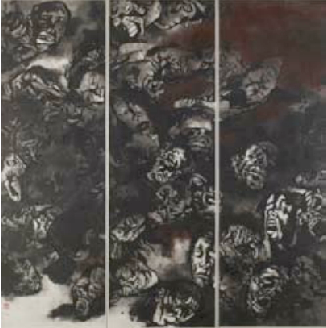
Yang Jiechang, Massacre, 1982
Ink and mineral colors on paper, 330 x 320 cm.
Lifelines 2 is a large ink painting from 1999 showing a group of people motionlessly watching some kind of event. Their heads appear like skulls. The artist took this image from a photography showing a crowd watching an execution in the streets of early Twentieth century Shanghai. Close to this monumental and powerful painting we see the artist’s Self-portrait at Forty, showing him naked with erect penis, which symbolizes the full creative energy. All the works in the exhibition are related to actual events and show the artist’s conviction that participation and action are major vectors of artistic creation. This position is also evident in his immediate and forceful brushwork that we encounter again in the small 2010 calligraphy reading Difficult that can be understood as a direct comment of the situation of our contemporary world.
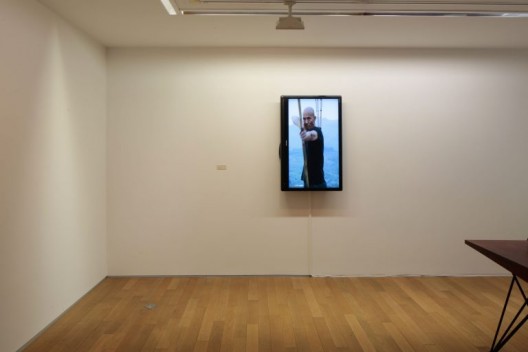 Exhibition view
Exhibition view
Photograph by Hervé Abbadie
The video Landscape Da Vinci similarly speaks of the aspect of participation and action, of positioning and re-positioning. It shows the artist shooting with an arrow at the camera. With every hit the image shivers until it stands still again only to be blurred again.
Yang believes that only participation, the acting individual, can change the state of being of a world entangled in the rough power play of globalization. Jene veux pas travailler – Stranger than Paradise Series (2010) and Mustard Seed Garden (2013) speak of this kind of globalized world.
Yang stages the interaction of animals of different species, as well as that of human beings with animals in a paradisiacal landscape. The dissimilar communication of the depicted couples ranges from curious discovery to playful contact and joyful mating. Boundaries, difference and prejudice seem to be forgotten, all is equal interplay, compassion and love. The depicted panorama relies on classical models stemming from the canon of traditional Chinese landscape painting and on the painting manual Mustard Seed Garden (1679), thus suggesting a kind of universal, eternal landscape.Yang’s image of a land where impartial communication and action is possible, is the image of a globalized world, yet one based on equality, on mutual respect and compassion. Equality, respect, compassion, love, hence harmony, are unstable relations. Once the balance between the big and the small, the strong and the week, the one on top and the one below is jeopardized, they turn into disparity, contempt, indifference, hate and aggression. The works remind us that even though all beings are interconnected in an essential unity of existence, harmony is still based on power play. Yes, the beauty and the potential of it all lie just in the instability of the balance that has to be defined and redefined through every individual act.
Yet, action is not reaction and comes from contemplation. Tibetan Pavilion – Self-Portrait at Fifty (2006), in which Yang combined a self-portrait with the portrait of the Dalai Lama speaks of the duality of the spiritual and the real. In this work Yang actually proposes the creation of a Tibetan Pavilion, of an autonomous cultural and spiritual sphere, where the “individual is free of political restriction”. Magic Wand, dating from 1989 is part of the Hundred Layers of Ink series as well as Relics 1 and Relics 3 – Gorintõ, both dating from 2014, similarly evoke the spiritual power of art as well as its potential of transformation. In all his works, whether extremely violent or more
spiritual, Yang Jiechang bring us beyond the visual, each work being a proposition for going beyond categories or sterile notions of identities fixed in time. The artist invites the viewer to consider art and life as an opened creative force, subject to multiple and
perpetual transformations. We are not observing easy pictural shapes calling for pictorial virtuosity ; for Yang Jiechang, it is the work of the spirit embedded in this pictorial forms which are complex and difficult and his oeuvre must be seen as an act of sublimation entirely devoted to a new beginning.
(Véronique Jaeger and Martina Koeppel-Yang)
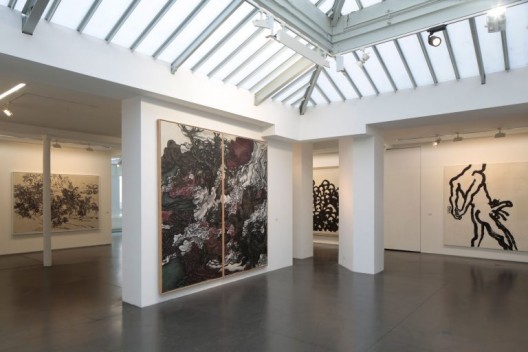
Exhibition view
Photograph by Hervé Abbadie



